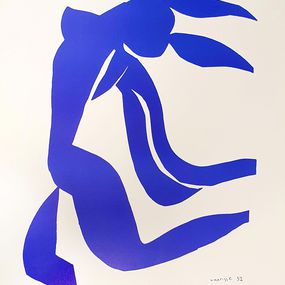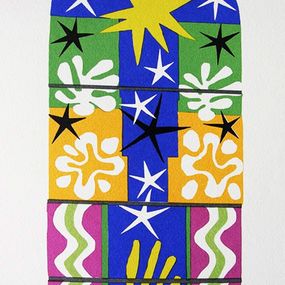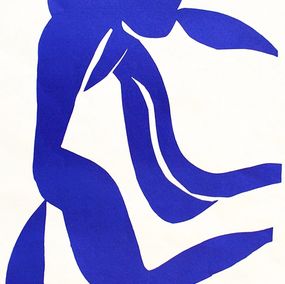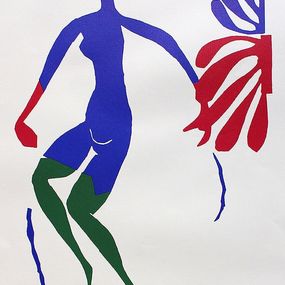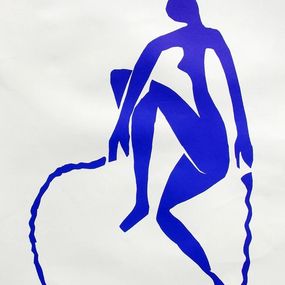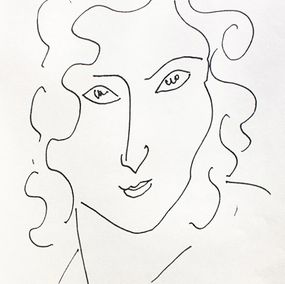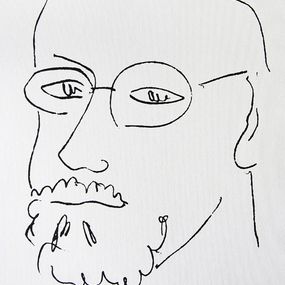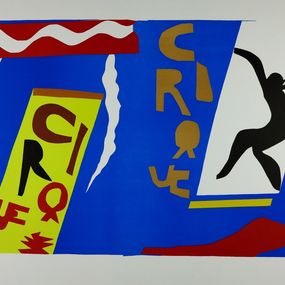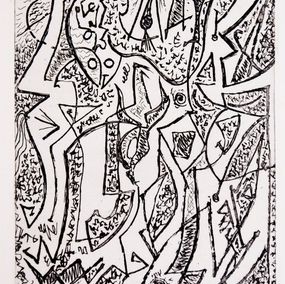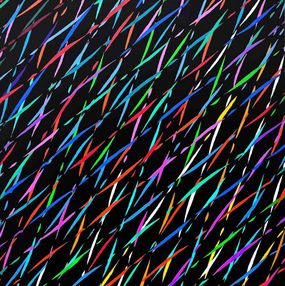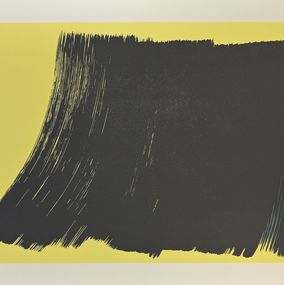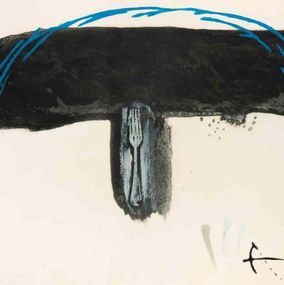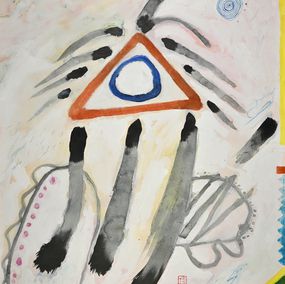
Figure assise, le bras droit appuye sur une table (Seated Figure),
1929
Henri Matisse
Print : dry point, etching
36 x 28 x 0.1 cm 14.2 x 11 x 0 inch
Free returns within 14 days
Authenticity guaranteed
Learn moreSecure payment
About the artwork
Type
Numbered and limited to 25 copies
1 copy available
Signature
Hand-signed by artist
Authenticity
Sold with certificate of Authenticity from the gallery
Invoice from the gallery
Medium
Dimensions cm • inch
36 x 28 x 0.1 cm 14.2 x 11 x 0 inch Height x Width x Depth
Support
Framing
Not framed
Artwork sold in perfect condition
Artwork location: Italy
Etching on Chine appliquè on Arches Velin paper.
Original title: Figure assise, le bras droit appuye sur une table
Hand signed and numbered on the lower right margin.
Edition of 3/25.
Includes matte (49 x 34 cm).
Reference:
Henri Matisse, Catalogue Raisonnè de l'Oeuvre Gravè, By Claude Duthuit, Paris, 1983 (n.215, pl 184).
Imagine it at home

Discover more by the artist
Presentation
Unanimously considered one of the greatest artists of the 20th century, Henri Matisse defies classification. He is, like Braque and Derain, one of the promoters of Fauvism, but, based on this revolt of color, his art is a reflection on line, on balance, on the synthesis of forms.
Son of a grain merchant from Le Cateau, Matisse began legal studies, passed his law degree in Paris (1888), and entered the office of a solicitor in Saint-Quentin as a clerk (1889); immobilized for a year by complications from appendicitis, he discovered the pleasure of painting. His mother, an amateur watercolorist, gave him a box of paints and, guided by the reading of a treatise by Frédéric Goupil, the young man amused himself by copying chromos. His first painting, Still Life with Books (Matisse Museum, Nice), is dated June 1890. Matisse had found his vocation and, abandoning law, enrolled at the Académie Julian to prepare for the entrance exam to the École nationale supérieure des beaux-arts. Exempted from this, thanks to the intervention of Gustave Moreau, in whose studio he worked from 1892, he will always keep a deep gratitude to this master, whose teaching awakens talents without constraining them. Rouault, Charles Camoin (1879-1965), Henri Evenepoel (1872-1899), Henri Manguin (1874-1949) are students of this studio and soon also Marquet, whom Matisse met at the evening classes of the School of Decorative Arts.
These years of study show wise research: copies at the Louvre (Fragonard, Delacroix, Chardin especially), landscapes executed outdoors in the company of Marquet and studio paintings accepted at the Salon of the National Society of Fine Arts, where the State bought in 1896 the Reading Girl for the Château de Rambouillet (today the Museum of Modern Art, Troyes). But, from this date, the revelation of Impressionism (meeting on Belle-Île with an artist friend of Claude Monet, John Russell [1858-1931]; discovery of the Caillebotte legacy at the Luxembourg Museum in 1897) and the wonder of the southern light (stay in Corsica, then in Toulouse, where his young wife, Noémie Parayre, was from) oriented Matisse's art towards new interests. He left the Beaux-Arts after the very academic Fernand Cormon replaced Moreau (?-1898) and attended the Académie Carrière, where he became friends with Derain, who introduced him to Vlaminck. In 1899, the purchase of Cézanne's Three Bathers (which he bequeathed to the City of Paris in 1936), a Head of a Boy by Gauguin and a drawing by Van Gogh revealed his predilection. In some paintings, such as Naked Man (1900, Pierre Matisse collection, New York), Matisse seems to be moving, like Rouault, towards an expressionism derived from Moreau's preparatory studies, treated with a knife in large planes. On the other hand, he discovered in his master an orgy of colors (Pasiphae, watercolor, Gustave Moreau Museum) which he in turn would organize according to his personal gifts; "You will simplify painting," Moreau predicted.
Before truly becoming himself, however, he still had one step to take. Since 1901, he had exhibited at the Salon des Indépendants, presided over by Paul Signac, whose text published in 1899 in the Revue Blanche and devoted to Neo-Impressionism he had meditated on. Meeting this artist again, accompanied by Henri Edmond Cross (1856-1910), in Saint-Tropez in 1904, he experimented with pointillism. The major work of this period, Luxe, calme et volupté (private collection), was exhibited at the Salon des Indépendants in 1905, where retrospectives of Seurat and Van Gogh were held. The revelation of the genius transcending a system in the one and denying all constraints in the other was completed during the summer by that of the Gauguin de Tahiti belonging to Daniel de Monfreid (1856-1929), whom Matisse and Derain visited during their vacation in Collioure.
Assimilating all these influences, the painter moved away from Divisionism: the brushstrokes broadened, the tones intensified, the lines became more flexible. This evolution led to the colorful violence of Woman with a Hat (1905, private collection, United States) and The Joy of Living (Barnes Foundation, Merion, United States).
However, the elementary excesses of Fauvism were short-lived for Matisse; his love affair with color was soon accompanied by an essential desire to organize tones in space. "I seek forces, a balance of forces," he noted about the Red Dessert (1908, Hermitage Museum, Saint Petersburg), which brought together all the magic of the arabesque, which would become one of the keys to his art.
Unlike the Impressionists , Matisse, like the other Fauves, was very quickly accepted by galleries (Berthe Weill, 1902; Druet, 1903; Ambroise Vollard, 1904; Bernheim-Jeune, 1910). In 1908, Paul Cassirer in Berlin and Alfred Stieglitz in New York devoted exhibitions to him. His fame quickly became international. Among his first admirers were some French, like Marcel Sembat and Paul Jamot, others American, like the Steins (who bought the Woman with a Hat in 1905). Sarah Stein, with the help of the painter Hans Purrmann, who had been subject to Matisse's influence since his arrival in Paris, encouraged him to found a school, where, from 1907 to 1911, he trained brilliant foreign students: the Norwegian Per Krohg (1889-1965) and the Swede Nils Dardel (1888-1943). From 1908 onwards, the Russian dealer Sergei Ivanovich Shchukin bought thirty-four paintings from Matisse, including the panels of Dance and Music (1909-1910, at the Hermitage), which he went there in 1911 to supervise their installation.
Travels (Germany, Italy, Morocco, Russia, the United States, etc.) brought Matisse a constantly renewed visual enrichment. From the stay in Biskra (1906), the memory of which is at the origin of the most expressionist of his paintings (the Blue Nude, 1907, Baltimore Museum of Art), to the stay in Tahiti (1930), whose impressions he transmuted into the Dance of the Barnes Foundation in Merion, the revelation "always came to him from the Orient". This taste, which had been awakened in 1903 by the exhibition of Muslim art at the Marsan pavilion in Paris, radiated into the "Odalisques" from 1921 to 1927. But, before that, Cubism , whose name was born from one of his jokes, touched upon the art of Matisse, who, having been discharged, was at the beginning of the war in Collioure, where Juan Gris (1887-1927) was also staying. The portrait of Yvonne Landsberg (1914, Philadelphia Museum of Art) illustrates this desire for neutral tones and geometry, but the forms inscribed in ovoid diagrams are similar to the lines of Negro statues, objects of interest to Matisse since 1906.
From 1917 onwards, Matisse spent the winter in Nice, preoccupied for a time with more abstract research on space and musicality: the Piano Lesson (1916 or 1917, Museum of Modern Art, New York) thus seems to immortalize the tempo of a "moderato cantabile". After the war, his style shows a relaxation, a return to ornamental delights to which his conversations with Renoir in 1918 are not unrelated. Paintings of intimacy where the brilliance of flowers and fruits compete with that of female flesh, the various Odalisques owe much to the watercolors of the Women of Algiers, for Delacroix, like Ingres, is one of the masters to whom Matisse likes to refer The Legion of Honor in 1925 and the Carnegie Prize in 1927 confirmed the painter's success. He returned to greater rigor through colored cutouts, which he used to prepare the large panels of the Dance (1931-1933) commissioned by Dr. Barnes. The sobriety is accentuated in the Pink Nude (1935, Baltimore Museum of Art). A constant concern for the interpenetration of figures in space without modeling, the play without thickness of colors and contours resulted in the different versions of the Striped Dress and the Romanian Blouse.
Despite war, old age, and illness, Matisse's sense of plastic invention remained intact, drawing inspiration from the curves of a rocaille armchair, reconnecting in the great Interiors of 1946-1948 with the colorful paroxysms of Fauvism, and seeking the symbiosis of all the arts in the decorative ensemble of the Rosary Chapel of the Dominican Sisters in Vence (1951). However, it was through the large, wildly evocative cut-out gouaches of dance or rest, of women, trees, or flowers that Matisse achieved "even more abstraction, even more unity" at the end of his life.
The same concerns appear in his sculptures , about seventy bronzes which, however, tackle head-on the problems of volumetric expression (as with the series of busts of Jeannette, 1910-1913). Likewise in his drawings and engravings (very numerous), his book illustrations: seventeen in all, among which the Poésies de Mallarmé (1932), the Lettres de la religieuse portugaise (1946) and the text entitled Jazz, masterfully accompanied by paper cut-outs (1947). In addition to the reflections included in this last album, Matisse wrote various texts, included in the collection Écrits et propos sur l'art published in 1972.
Throughout his career, the same themes prevail: open windows, indolent women, a world of laziness completely antithetical to its creator and, above all, a pretext for exploring the artistic field. "Work cures everything," said Matisse. The painter's work, of apparent simplicity, "this fruit of dazzling light" beloved by Apollinaire, is born of relentless labor, which always seeks to bear witness to the inexpressible sensation that one of his last paintings bears the title: The Inhabited Silence of Houses.
More works from Wallector Srl
Artsper delivers internationally. The list of countries is available in the first step of your cart.
If your country is not listed contact us at [email protected] and we will see what we can do.
Note that Customs fees may apply for works shipped internationally. This is indicated in the first step of the shopping cart.
You can choose a delivery address different from the billing address. Make sure that a trusted person is present to receive the work if you cannot be there.
Have you purchased a painting, sculpture or work on paper?
Find our expert advice for the conservation and promotion of your works in the articles below:
Artsper offers you access to more than 200,000 works of contemporary art from 2,000 partner galleries. Our team of experts carefully selects galleries to guarantee the quality and originality of the works.
You benefit from:
-
Works at gallery price
-
Return within 14 days, regardless of your location
-
Easy resale of the work purchased on Artsper
-
Personalized research tools (selection and tailor-made universe)
Our customer service is available for any assistance.
At Artsper, our mission is to allow you to collect works of art with complete peace of mind. Discover the protections we offer at every stage of your shopping experience.
Buy works from top galleries
We work in close collaboration with carefully selected art galleries. Each seller on Artsper is carefully examined and approved by our team, thus ensuring compliance with our code of ethics. You therefore have the assurance of purchasing authentic, high-quality works.
Total transparency: you know what you are buying
Before being posted online, all artwork on Artsper is reviewed and validated by our moderation team. You can browse with complete peace of mind, knowing that each piece meets our criteria of excellence.
Personalized support: our experts at your service
Our team of contemporary art experts is available by phone or email to answer all your questions. Whether you want advice on a work or a tailor-made selection to enrich your collection, we are here to support you.
Resell your works with ease
If you have purchased a work on Artsper and wish to resell it, we offer you a dedicated platform to relist it. To find out more, click here.
Make offers with Artsper: negotiate like in a gallery
You have the possibility to propose a price for certain works, just like in a gallery. This feature allows you to initiate discussions and potentially acquire your coins at advantageous prices.
Get help with your negotiations
Our team will negotiate for you and inform you as soon as the best offer is obtained. Do not hesitate to call on our expertise to ensure a transaction at the best price.
Order securely
Artsper satisfaction assurance
We want you to be completely satisfied with your purchase. If the work you receive is not to your liking, you have 14 days to return it free of charge, and you will be refunded in full, whatever the reason.
Secure payment with Artsper partners
All credit card payments are processed by Paybox, the world leader in payment solutions. Thanks to their strict security standards, you can transact with confidence.
Problem Support
In the rare event that an artwork arrives damaged or not as described, we are here to help. Whether for a return, refund, restoration or exchange, our team will support you throughout the process and will ensure that we find the solution best suited to your situation.
Conditions to benefit from Artsper protections:
-
Use one of the payment methods available on Artsper for your order.
-
Report any problems within one week of receiving the work.
-
Provide required photographic evidence (including original artwork and packaging).
Artsper guarantees cover the following cases:
-
The received work lacks a described characteristic (for example, a signature or frame).
-
The artwork has significant differences from its description (e.g. color variation).
-
The work is damaged upon receipt.
-
The work is lost or damaged by the carrier.
-
Delivery is significantly delayed.
With Artsper, you collect with complete peace of mind.







